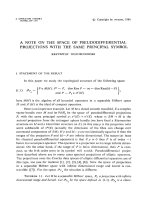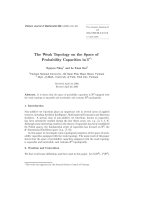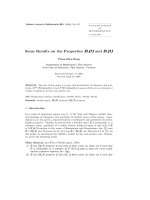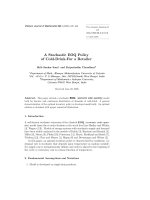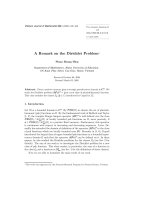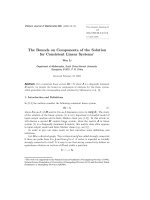Báo cáo toán học: "The Bounds on Components of the Solution for Consistent Linear Systems" pdf
Bạn đang xem bản rút gọn của tài liệu. Xem và tải ngay bản đầy đủ của tài liệu tại đây (97.68 KB, 5 trang )
Vietnam Journal of Mathematics 33:1 (2005) 91–95
The Bounds on Components of the Solution
for Consistent Linear Systems
*
Wen Li
Department of Mathematics, South China Normal University
Guangzhou 510631, P. R. China
Received February 27, 2004
Abstract. For a consisten t linear system
Ax = b, where A is a diagonally dominant
Z-matrix, we present the bound on components of solutions for this linear system,
which generalizes the corresponding result obtained by Milaszewicz et al. [3].
1. Introduction and Definitions
In [2, 3] the a uthors consider the following consistent linear system
Ax = b, (1)
where A is an n×nM-matrix, b is an n dimension vector in rang(A). The study
of the solution of the linear system (1) is very important in Leontief model of
input-output analysis and in finite Markov chain (see [1, 2]). In this article we
will discuss a special M -matrix linear system, when the matrix A in linear
system (1) is a diagonally dominant
L-matrix; this matrix class often appears
in input-output model and finite Markov chain (e.g., see [1]).
In order to give o ur main result we first introduce some definitions and
notations.
Let G be a directed graph. Two vertices i and j are called strongly connected
if there a re paths from i to j and from j to i. A vertex is regarded as trivially
strongly connected to itself. It is easy to see that strong connectivity defines an
equivalence relation on vertices of G and yields a partition
V
1
∪ ∪ V
k
∗
This work was supported by the Natural Science Foundation of Guangdong Province (31496),
Natural Science Foundation of Universities of Guangdong Province (0119) and Excellent Talent
Foundation of Guangdong Province (Q02084).
92 Wen Li
of the vertices of G. The directed subgraph G
V
i
with the vertex set V
i
of G is
called a strongly connected component of G, i =1, , k. Let G = G(A)bean
associated directed graph of A. A nonempty subset K of G(A)issaidtobea
nucleus if it is a strongly connected comp onent of G(A) (see [3]). For a nucleus
K, N
K
denotes the set of indices involved in K.
A matrix or a vector B is nonnegative (p ositive) if each entry of B is nonneg-
ative (positive, respectively). We denote them by B ≥ 0andB>0. An n × n
matrix A =(a
ij
) is ca lled a Z -matrix if for any i = j, a
ij
≤ 0, a L-matrix if A
is a Z-matrix with a
ii
≥ 0,i=1, , n and an M-matrix if A = sI − B, B ≥ 0
and s ≥ ρ(B), where ρ(B) denotes the spectral radius of B. Notice that A is a
singular M-matrix if and only if s = ρ(B). An n × n matrix A =(a
ij
)issaidto
be diagonally dominant if 2|a
ii
|≥
n
j=1
|a
ij
|,i=1, , n.
Let N = {1, , n},A∈ R
n×n
and α be a subset of N .WedenotebyA[α]
the principal submatrix of A whose rows and co lumns are indexed by α. Let
x ∈ R
n
. By x[α] we mean that the subvector of x whose subscripts are indexed
by α.
Milaszewicz and Moledo [3] studied the above linear system and presented
the following result, on which we make a slight modification.
Theorem 1.1. Let A be a nonsingular, diagonally dominant Z-matrix. Then
the solution of linear system (1) has the following properties:
(i) If N
K
∩ N
>
(b) = ∅ for each nucleus K of A, then
x
i
≤ D, ∀i ∈ N,
where D =max{0,x
j
: b
j
> 0} and N
>
(b)={i ∈ N : b
i
> 0}.
(ii) If N
K
∩ N
<
(b) = ∅ for each nucleus K of A, then
d ≤ x
i
, ∀i ∈ N.
where d =min{0,x
j
: b
j
< 0} and N
<
(b)={i ∈ N : b
i
< 0}.
Remark. Theorem 1.1 is a generalization of Theorem 7 in [2].
In this note we will extend Theorem 1.1; see Theorem 2.4.
2. The Bounds
For the rest of this note we set N
>
,N
<
,Dand d as in Theorem 1.1. For
consistent linea r system (1), by A
≥
and A
≤
we denote the principal submatrices
of A whose rows and columns are indexed by the subsets {i ∈ N : b
i
≥ 0} and
{i ∈ N : b
i
≤ 0}, resp ectively.
Now we give some lemmas which will lead to the main theorem in this note.
Lemma 2.1. Let A be a diagonally dominant
L-matrix. Then A is an M-matrix.
Proof. Since A is a diagonally dominant Z-matrix, Ae≥ 0, where e =(1, 1, ,1)
t
.
Let A = sI − B, where s ∈ R and B is nonnegative. It follows from Perron-
The Bounds on Comp onents of the Solution for Consistent Linear Systems 93
Frobenius Theorem on nonnegative matrices (e.g., see [1]) that there is a nonneg-
ative nonzero vector y such that y
t
B = ρ(B)y
t
. Thus 0 ≤ y
t
Ae =(s−ρ(B
t
))y
t
e.
Since y
t
e>0, we have s ≥ ρ(B). Hence A is an M-matrix.
Lemma 2.2. Let A ∈ R
n×n
be an M-matrix, b ∈ R
n
and b(N
K
) =0for each
nucleus K of A.
(i) If A
≥
is a nonsingular M-matrix, then whenever x(N
<
(b)) > 0 we have
x>0.
(ii) If A
≤
is a nonsingular M-matrix, then whenever x(N
>
(b)) < 0 we have
x<0.
Proof.
(i) Follows from Theorem 3.5 of [4].
(ii) By (1) we have
A(−x)=−b. (2)
By (i) it is easy to see that (ii) holds.
Lemma 2.3. Let A be a diagonall y dominant L-matrix. If there exist a vector
x and a positive vector b such that Ax = b, then A is a nonsingular M-matrix.
Proof. By Lemma 2.1, A is an M-matrix. Assume that A is singular. Then
so is A
t
. Let A
t
= sI − B, s ∈ R and B is no nnegative. Then s = ρ(B). It
follows from Perron-Frobenius Theorem of nonnegative matrices that there is a
nonnegative nonzero vector y such that By = ρ(B)y. Thus
y
t
A = y
t
(sI − B
t
)=(s − ρ(B))y
t
=0,
which implies that y
t
b = y
t
Ax =0. Since y ≥ 0,y=0andb>0, we have
y
t
b>0, which contradicts the assumption. Hence A is a nonsingular M-matrix.
The following theorem is our main result in this note.
Theorem 2.4. Let A be a diagonally dominant
L-matrix, b(N
K
) =0for each
nucleus K. Then the solution of the linear system (1) has the following properties:
(i) If A
≤
is a nonsingular M -matrix (or empty matrix) then
x
i
≤ D, ∀i ∈ N.
(ii) If A
≥
is a nonsingular M -matrix (or empty matrix), then
x
i
≥ d, ∀i ∈ N.
Proof. It is enough to show that (i) holds. The proof of (ii) is similar. We
consider the following three cases.
Case 1. If N
>
(b)=N, then b>0. It follows from Lemma 2.3 that A is a
nonsingular M-matrix. Hence the result follows immediately from Theorem 3.1
of [3].
94 Wen Li
Case 2. If N
>
(b)=∅, then A
≤
= A is a nonsingular M-matrix. By Theorem
6.2.3 of [1] we have A
−1
≥ 0. Hence x = A
−1
b ≤ 0 , which leads to our result.
Case 3. If ∅⊂N
>
(b) ⊂ N, then we consider the following two subcases.
Sub case 3.1. If x(N
>
(b)) < 0, then it follows x<0 from Lemma 2.2 (ii), which
implies that the theorem holds.
Sub case 3.2. Now we assume that there exists j ∈ N
>
(b) such that x
j
> 0. It is
enough to show that x
j
≤ max{x
i
: b
i
> 0}.
Since ∅⊂N
>
(b) ⊂ N, the sets α = N
>
(b)andβ = {i ∈ N : b
i
≤ 0}
form a partition of the set N. Hence there is a permutation matrix P such that
Pb =
b
(1)
b
(2)
,whereb
(1)
= b[α]andb
(2)
= b[β]. Hence b
(1)
> 0andb
(2)
≤ 0.
Let
PAP
t
=
A
11
A
12
A
21
A
22
, (3)
where A
11
= A[α]andA
22
= A[β]=A
≤
. By(1)wehave(PAP
t
)Px = Pb. Let
Px =
x
(1)
x
(2)
be conformably with the block form (3). Then x
(1)
= x[α]and
x
(2)
= x[β]. Hence A
21
x
(1)
+ A
22
x
(2)
= b
(2)
. Since b
(2)
≤ 0, we have A
22
x
(2)
≤
A
21
x
(1)
. By the assumption that A
≤
is a nonsingula r M-matrix we have A
−1
22
=
A
−1
≤
≥ 0, from which we have
x
(2)
≤−A
−1
22
A
21
x
(1)
. (4)
Since A is diagonally dominant Z-matrix, Ae≥ 0. Let e =
e
(1)
e
(2)
be con-
formably with the block form (3). Then A
21
e
(1)
+A
22
e
(2)
≥ 0, i.e., −A
−1
22
A
21
e
(1)
≤ e
(2)
. Let x
m
=max{x
i
: b
i
> 0}. Then x
m
> 0andx
(1)
≤ x
m
e
(1)
. Notice that
−A
−1
22
A
21
≥ 0, then by (4) we have x
(2)
≤−A
−1
22
A
21
x
(1)
≤−x
m
A
−1
22
A
21
e
(1)
≤
x
m
e
(2)
, from which one can deduce that the theorem holds.
Corollary 2.5. L et A be a diagonally dominant L-matrix and b(N
K
) =0for
each nucleus K. If A
≥
and A
≤
are nonsingular, then the solution of the linear
system (1) satisfies
d ≤ x
i
≤ D, ∀i ∈ N.
Proof. The result follows from Lemma 2.1, Lemma 2.2 and Theorem 2.4.
Corollary 2.6. Let A be a nonsingular, diagonally dominant L-matrix, and
b(N
K
) =0for each nucleus K. Then the solution of the linear system (1) satisfies
d ≤ x
i
≤ D, ∀i ∈ N.
Proof. By Lemma 2.1, A is a nonsingular M-matrix. Since each principal sub-
matrix of a nonsingular M-matrix is a nonsingular M-matrix, the result follows
from Corollary 2.5.
Corollary 2.7. Let A be an irreducible diagonally dominant L-matrix, and
b =0. Then the solution o f linear system (1) satisfies
The Bounds on Comp onents of the Solution for Consistent Linear Systems 95
d ≤ x
i
≤ D, ∀i ∈ N.
Proof. The result follows immediately from Corollary 2.6.
Remark. If N
K
∩ N
>
(b) = ∅ or N
K
∩ N
<
(b) = ∅ for each nucleus K of A,
then b(N
K
) = 0 for each nucleus K of A on one hand. On the other hand, in
Theorem 2.4 and Corollary 2.5 we need not to assume that A is nonsingular.
Hence from the fact that each principal submatrix of a nonsingular M-matrix
is also a nonsingular M-matrix, we know that Theorem 2.4 and Corollary 2.5
extend Theorem 1.1.
References
1. A. Berman and R. J. Plemmon, Nonnegative Matrices in the Math.,Academic
Press, New York, 1979.
2. G. Sierksma, Nonnegative matrices: The open Leon tief model, Linear Algebra
Appl. 26 (1979) 175–201.
3. J. P. Milaszewicez and L. P. Moledo, On nonsingular
M-matrices, Linear Algebra
Appl. 195 (1993) 1–8.
4. W. Li, On the property of solutions of
M-matrix equations, Systems Science and
Math. S cience 10 (1997) 129–132.



